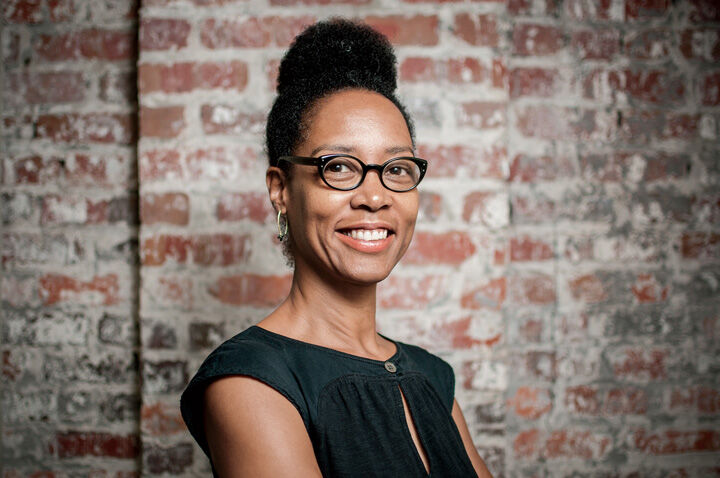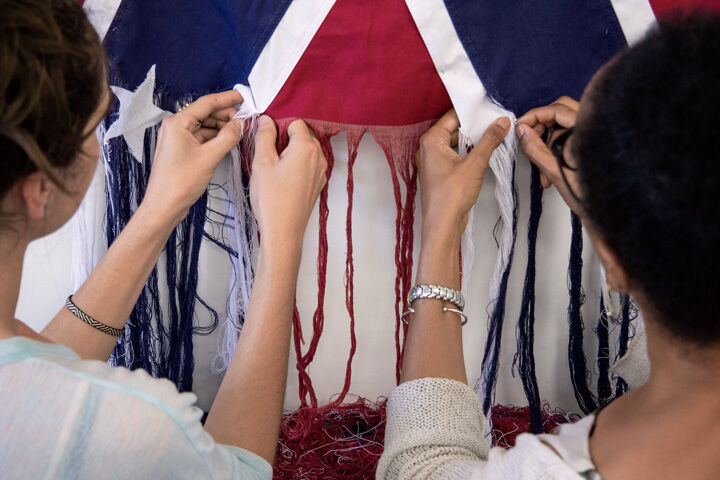
Q&A with Sonya Clark (BFA 1993)
Distinguished Alumni Lecturer, Visiting Artists Program

In her work, Sonya Clark (BFA 1993) traces connections between hair and textiles, communities and commodities, and radicalized identities. Clark has exhibited her work in more than 300 museums and galleries around the globe and is Chair of the Craft and Material Studies Department at Virginia Commonwealth University School of the Arts in Richmond. On March 28, she returns to SAIC as the Distinguished Alumni Lecturer.
How did you develop an interest in working with hair?
When I was a kid, my Jamaican grandmother used to travel the globe to visit all of her children and grandchildren. She was a tailor by profession, and when she would spend time with me in Washington, DC, she would say, “Come and stitch with me, and I’ll tell you stories.” I’m not sure which I enjoyed more, the stitching or the stories. Around that same time, the ambassador from the country of Benin and his family lived across the street from us. My sister and I spent a lot of time over there. His daughters would comb our hair into elaborate West African styles. So, at home, my grandmother was teaching me how to stitch, and across the street, I was getting these magnificent sculptures made out of hair on my head. That was my first inkling that hair was art. And my first linking of hair and textiles. Fast forward to SAIC, my main teachers in the Fiber department were Joan Livingstone, Nick Cave, and Anne Wilson. Anne, of course, was stitching with hair. I think the first project I made with hair was at SAIC.
Do you see your work as political?
Being an artist is a political act because we are in a capitalist nation where the arts, as a whole, are not valued much. At the same time, we know a simple image or song can affect great political change. Artists have the freedom and power to work with subtle materials in impactful ways. I often use simple means to reflect on power structures. Like in my Hair Craft Project, feminism and Black culture are at the roots of the project. It’s about pushing back against notions of European hegemony, supremacy, and male power. Taking two things that are considered feminine—women’s hair braiding and textile arts—and asserting them unapologetically as art with a capital A, that is a political act. Hairdressing techniques that connect to the heart of African aesthetics, being made right here by Richmond hairdressers, honoring those legacies and women as purveyors of culture in the context of America’s history of racial inequity, yeah, it’s political. And that’s just one example.

How do you address the political using cloth?
This year I had a show in Charlottesville, Virginia, called Bitter, Sweet, and Tender about the commodification of people. One of the pieces that I made for that show was the flag that actually brought this nation together. It’s a dishrag that was made in Richmond. It made its way to Appomattox as a humble cloth, but because it was a white piece of cloth, it’s what Lee used to surrender to Grant. It became repurposed as the Confederate Flag of Truce and ended the Civil War. Folks know the Confederate Flag, but few would recognize the humble cloth that brought our nation together. What’s interesting is the truce flag was divided in half. Half is in the National Museum of American History. The other half was divided into lots of little pieces and is in various museums and private collections. The flag that brought our nation together has been taken apart and dispersed.
I wanted to highlight this story. I created a series of reproductions of the truce flag woven in the same waffle weave and out of the same kind of linen. I tea-stained some to mimic the old cloth and left others bright white, to reflect how the cloth might have been in its nascent state. Who chooses what cloth becomes a political symbol? That’s the power of art and storytelling.
See Sonya Clark’s Distinguished Alumni Lecture presented by the Visiting Artists Program and the Office of Alumni Relations on Tuesday, March 28, 6:00 p.m., at the Art Institute of Chicago, Rubloff Auditorium, 230 South Columbus Drive. Click here to learn more.
